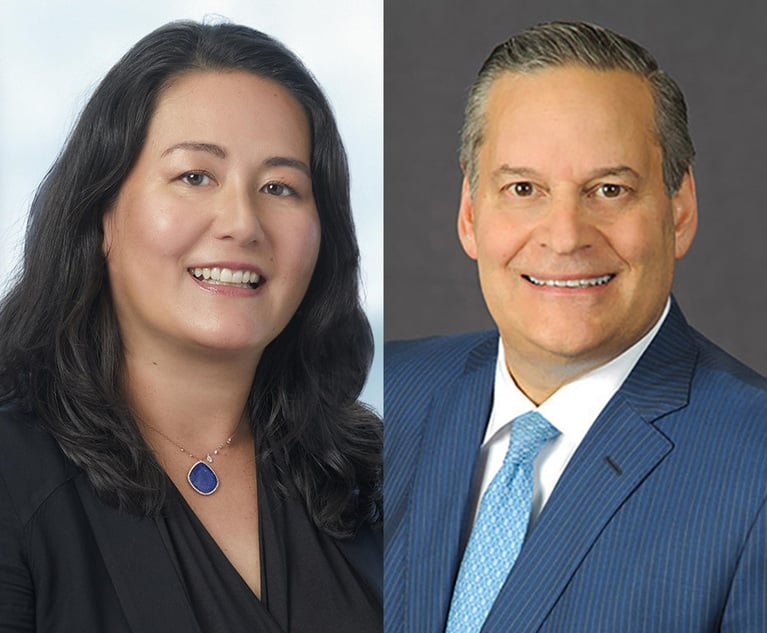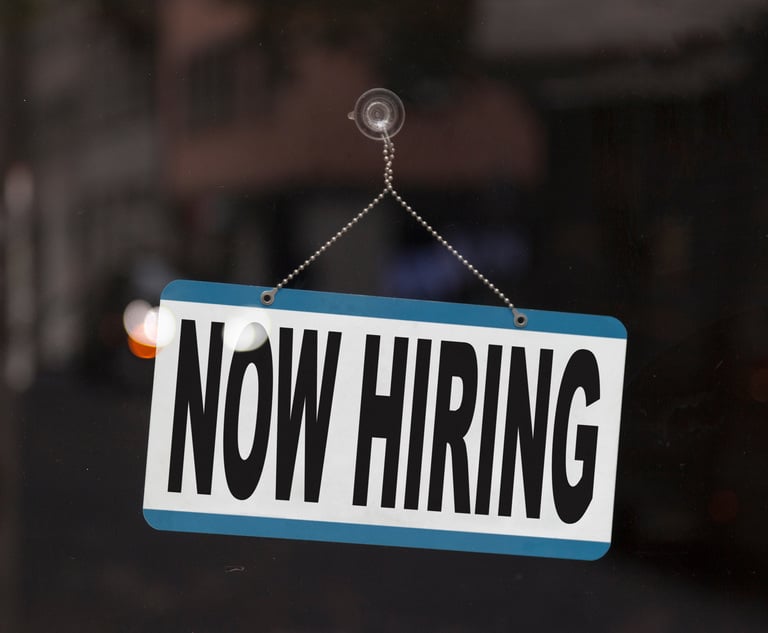Emory Law Makes 'Go-To' List of Schools Sending Most Grads to Biggest Firms
Emory was the only Georgia law school to make the list, with 45 of its 296 graduates, or 15 percent, going to the biggest firms.
March 15, 2018 at 12:21 PM
3 minute read

Fifteen percent of 2017 graduates from Emory University law school went to work at one of the 100 largest law firms in the country.
That figure put Emory at No. 29 on Law.com's “Go-To Law Schools” list, which recognizes the 50 law schools that send the highest percentage of graduates to the 100 U.S. firms with the most lawyers. Columbia University in New York took the top spot, with 292 of its 432 graduates, or 68 percent, going to the biggest firms. (Law.com is a Daily Report affiliate.)
Emory was the only Georgia law school to make the list, with 45 of its 296, or 15 percent, of graduates going to the biggest firms. Those firms include: King & Spalding, Alston & Bird and Kilpatrick Townsend & Stockton, but Dentons—which has a large Atlanta office—is not on that list, as it is not based in the U.S.
Georgia State University law school saw 15 of its 184 graduates, or 8 percent, go to the biggest firms.
The University of Georgia law school followed with 10 of its 181, or 6 percent.
Mercer University law school had 3 of its 125 grads, 2 percent, go to the biggest firms. Atlanta's John Marshall Law School had 1 of its 142 grads, or 1 percent, go to the biggest firms. (Results from all law schools are here.)
The “Go-To” survey also listed schools by how many of its graduates were made partners at the biggest firms in 2017. Emory was 15th, with 17 alumni making partner. Georgia was 28th, with 13. Harvard led the list with 62.
Two of the five Georgia law schools offered comments about the list.
“At Georgia State University College of Law, the goal of our department is to help each student find the right employment opportunity specifically for them, regardless of firm size,” said Lyn Knapp, senior director of GSU Law's Center for Professional Development and Career Strategies.
“At the University of Georgia School of Law, we are proud of our students' record of employment,” said Kenny Tatum, UGA law's senior director of career development. “We work hard to help them find positions where they can put their legal training into practice—this includes opportunities in judicial chambers, government agencies, nonprofits, small firms and large firms.”
“Like all law schools, we will report our Class of 2017 employment outcomes to the ABA on April 6,” he said. “However, our current records indicate we have more 2017 graduates working for firms with greater than 500 attorneys than were included in the results of this particular survey.”
This content has been archived. It is available through our partners, LexisNexis® and Bloomberg Law.
To view this content, please continue to their sites.
Not a Lexis Subscriber?
Subscribe Now
Not a Bloomberg Law Subscriber?
Subscribe Now
NOT FOR REPRINT
© 2025 ALM Global, LLC, All Rights Reserved. Request academic re-use from www.copyright.com. All other uses, submit a request to [email protected]. For more information visit Asset & Logo Licensing.
You Might Like
View All
Sanctions Order Over Toyota's Failure to Provide English Translations of Documents Vacated by Appeals Court
4 minute read
Burr & Forman, Smith Gambrell & Russell Promote More to Partner This Year
7 minute read
Trending Stories
- 1Restoring Trust in the Courts Starts in New York
- 2'Pull Back the Curtain': Ex-NFL Players Seek Discovery in Lawsuit Over League's Disability Plan
- 3Tensions Run High at Final Hearing Before Manhattan Congestion Pricing Takes Effect
- 4Improper Removal to Fed. Court Leads to $100K Bill for Blue Cross Blue Shield
- 5Michael Halpern, Beloved Key West Attorney, Dies at 72
Who Got The Work
Michael G. Bongiorno, Andrew Scott Dulberg and Elizabeth E. Driscoll from Wilmer Cutler Pickering Hale and Dorr have stepped in to represent Symbotic Inc., an A.I.-enabled technology platform that focuses on increasing supply chain efficiency, and other defendants in a pending shareholder derivative lawsuit. The case, filed Oct. 2 in Massachusetts District Court by the Brown Law Firm on behalf of Stephen Austen, accuses certain officers and directors of misleading investors in regard to Symbotic's potential for margin growth by failing to disclose that the company was not equipped to timely deploy its systems or manage expenses through project delays. The case, assigned to U.S. District Judge Nathaniel M. Gorton, is 1:24-cv-12522, Austen v. Cohen et al.
Who Got The Work
Edmund Polubinski and Marie Killmond of Davis Polk & Wardwell have entered appearances for data platform software development company MongoDB and other defendants in a pending shareholder derivative lawsuit. The action, filed Oct. 7 in New York Southern District Court by the Brown Law Firm, accuses the company's directors and/or officers of falsely expressing confidence in the company’s restructuring of its sales incentive plan and downplaying the severity of decreases in its upfront commitments. The case is 1:24-cv-07594, Roy v. Ittycheria et al.
Who Got The Work
Amy O. Bruchs and Kurt F. Ellison of Michael Best & Friedrich have entered appearances for Epic Systems Corp. in a pending employment discrimination lawsuit. The suit was filed Sept. 7 in Wisconsin Western District Court by Levine Eisberner LLC and Siri & Glimstad on behalf of a project manager who claims that he was wrongfully terminated after applying for a religious exemption to the defendant's COVID-19 vaccine mandate. The case, assigned to U.S. Magistrate Judge Anita Marie Boor, is 3:24-cv-00630, Secker, Nathan v. Epic Systems Corporation.
Who Got The Work
David X. Sullivan, Thomas J. Finn and Gregory A. Hall from McCarter & English have entered appearances for Sunrun Installation Services in a pending civil rights lawsuit. The complaint was filed Sept. 4 in Connecticut District Court by attorney Robert M. Berke on behalf of former employee George Edward Steins, who was arrested and charged with employing an unregistered home improvement salesperson. The complaint alleges that had Sunrun informed the Connecticut Department of Consumer Protection that the plaintiff's employment had ended in 2017 and that he no longer held Sunrun's home improvement contractor license, he would not have been hit with charges, which were dismissed in May 2024. The case, assigned to U.S. District Judge Jeffrey A. Meyer, is 3:24-cv-01423, Steins v. Sunrun, Inc. et al.
Who Got The Work
Greenberg Traurig shareholder Joshua L. Raskin has entered an appearance for boohoo.com UK Ltd. in a pending patent infringement lawsuit. The suit, filed Sept. 3 in Texas Eastern District Court by Rozier Hardt McDonough on behalf of Alto Dynamics, asserts five patents related to an online shopping platform. The case, assigned to U.S. District Judge Rodney Gilstrap, is 2:24-cv-00719, Alto Dynamics, LLC v. boohoo.com UK Limited.
Featured Firms
Law Offices of Gary Martin Hays & Associates, P.C.
(470) 294-1674
Law Offices of Mark E. Salomone
(857) 444-6468
Smith & Hassler
(713) 739-1250







